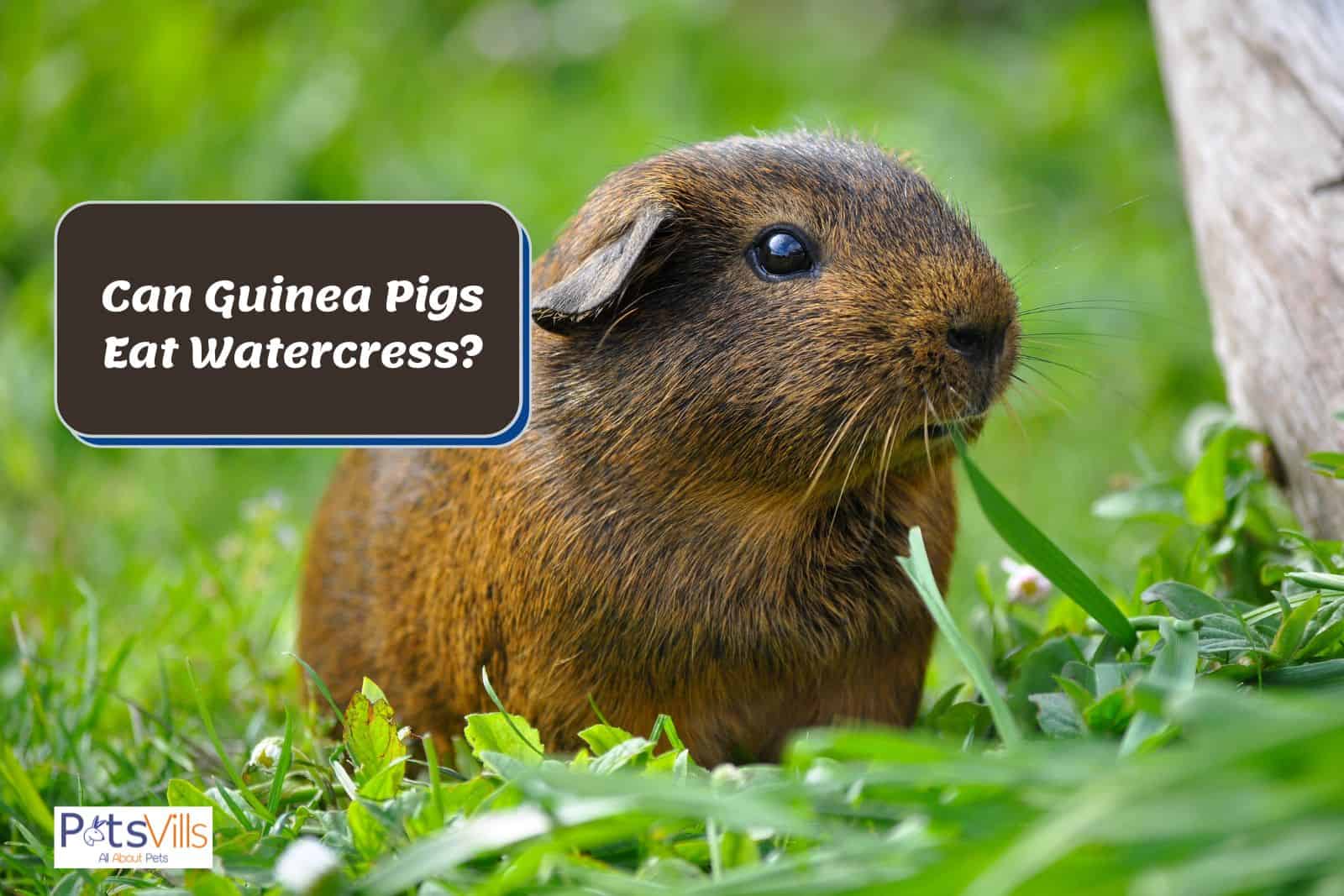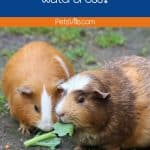I’ve always loved the taste of watercress. So I thought my guinea pig would love it too, which led me to research whether it’d be an excellent addition to his diet.
Can guinea pigs eat watercress? According to experts, guinea pigs can eat uncooked/cooked watercress in small amounts. It’s a beneficial addition to a cavy’s diet due to its vitamin C content (1).
But there’s much more to this conversation than if a cavy can eat it.
So read on, and find out if this plant is what your cavy’s diet has been missing!
Table of Contents
Key Takeaways
- Watercress is a safe vegetable for guinea pigs in small doses. Its high water content can cause digestive issues when overeating.
- Owners will want to limit its usage down to an occasional treat. In these situations, watercress works well as an additional vitamin C supplement.
- Several health benefits come from feeding watercress to guinea pigs. Some include boosting their immune system, maintaining strong bones, and preventing scurvy.
Is It Safe For Guinea Pigs To Eat Watercress?
Watercress is a safe food for guinea pigs to eat. In fact, this veggie offers various benefits, with it being “high in fiber and vitamins K and C” (2).
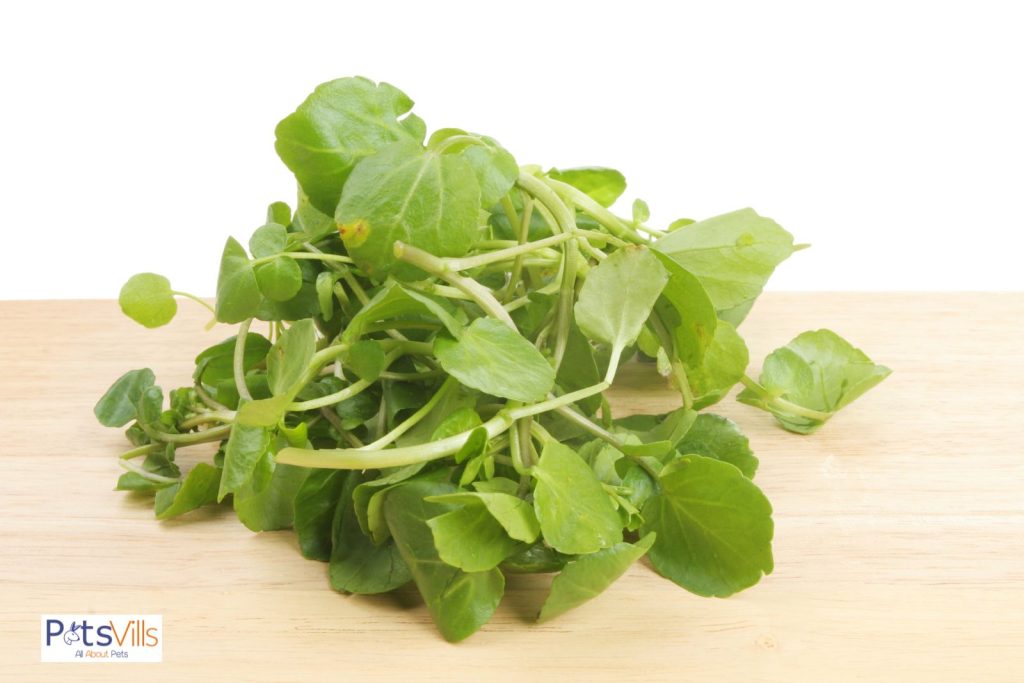
But watercress only remains beneficial in small amounts. Sadly, the veggie can become dicey when your cavy overeats it.
The issue comes from it having a high water and vitamin A content. As a result, it’ll cause your cavy to have diarrhea and bloating.
However, a small amount of watercress won’t do any harm. I’ve actually been using it as a treat with my guinea pigs for years.
Can Baby Guinea Pigs Eat Watercress?
Baby guinea pigs can eat watercress, but it’s a good idea to wait until they’re three weeks old.
Before then, a cavy’s digestive system won’t be able to handle solid food. So owners must wait at least three weeks to give them solid food like watercress.
You can also give the mother a small handful of watercress during the first weeks. She may use it to help her baby cavies how to eat solid foods.
Don’t force her or the baby to eat it if she doesn’t. It’s best to let the mother cavy determine what’s right for the baby during these initial weeks.
After three weeks, you can give the babies a small amount of watercress. It’ll let you see if there’s an adverse reaction, such as vomiting or diarrhea.
If either presents themselves, stop feeding them watercress. It’s not worth the aggravation or health issues to continue.
But if your baby cavy enjoys it without any issues, there’s no reason not to provide them with more.
I’d suggest sticking with a small amount of watercress once a week. It has been a productive feeding schedule for my guinea pig without any vomiting or digestive issues.
Health Benefits of Watercress for Guinea Pigs
Watercress is a reliable source of several vital nutrients, offering outstanding health benefits. It’s why many guinea pig owners look to use it in their cavy’s diet.
But before we dive into the health benefits, I thought it’d be wise to look at the nutritional data provided by “ one cup (34 grams) of watercress “(3):
- Calories: 4
- Carbs:0.4 grams
- Protein:0.8 grams
- Fat:0 grams
- Fiber:0.2 grams
- Vitamin A: 22%
- Vitamin C: 24%
- Vitamin K: 106%
- Calcium: 4%
- Manganese: 4%
Since you’ve now got a handle on its nutritional data, it’s time to look at what these nutrients provide health-wise. You’ll soon see why it’s such a valuable cavy treat.
1. Boosts Immune System
One of the primary benefits provided by watercress is its high vitamin C content. It’s a crucial addition for guinea pigs, especially since their bodies can’t create vitamin C.
So they need to get it from outside sources. As a result, watercress can be a truly beneficial tool in a cavy’s diet.
The vitamin C will then boost their immune system to prevent infections and other sicknesses. Honestly, a cavy who gets plenty of vitamin C is much less likely to get sick.
On a similar note, I like to use watercress when my cavies do get sick. It can help speed up their recovery time.
2. Maintains Healthy Bones
Your guinea pig’s bones will benefit significantly from watercress’ high calcium and vitamin K content. These nutrients are vital to developing and maintaining healthy bones.
In particular, calcium will make their bones stronger and denser (4). Therefore, it’ll help them prevent breaks and other similar issues.
Meanwhile, vitamin K modifies the proteins that form the bone, which will improve bone health. It also enhances the absorption of calcium in the body.
3. Prevents Scurvy
Scurvy is a disease caused by severe and chronic vitamin C deficiency (5). It’s a prominent disease among domesticated guinea pigs.
This disease isn’t one to overlook, either. Scurvy can make guinea pigs become incredibly sick and kill them.
Thankfully, watercress can help prevent it with its high levels of vitamin C. It’ll ensure your guinea pig doesn’t suffer from this horrible disease.
CHECK: Can Guinea Pigs Eat Lavender?
How To Feed Watercress To Guinea Pigs?
Two possible methods of feeding watercress to guinea pigs are: giving it straight to them or mixing it with other fresh vegetables/fruits.
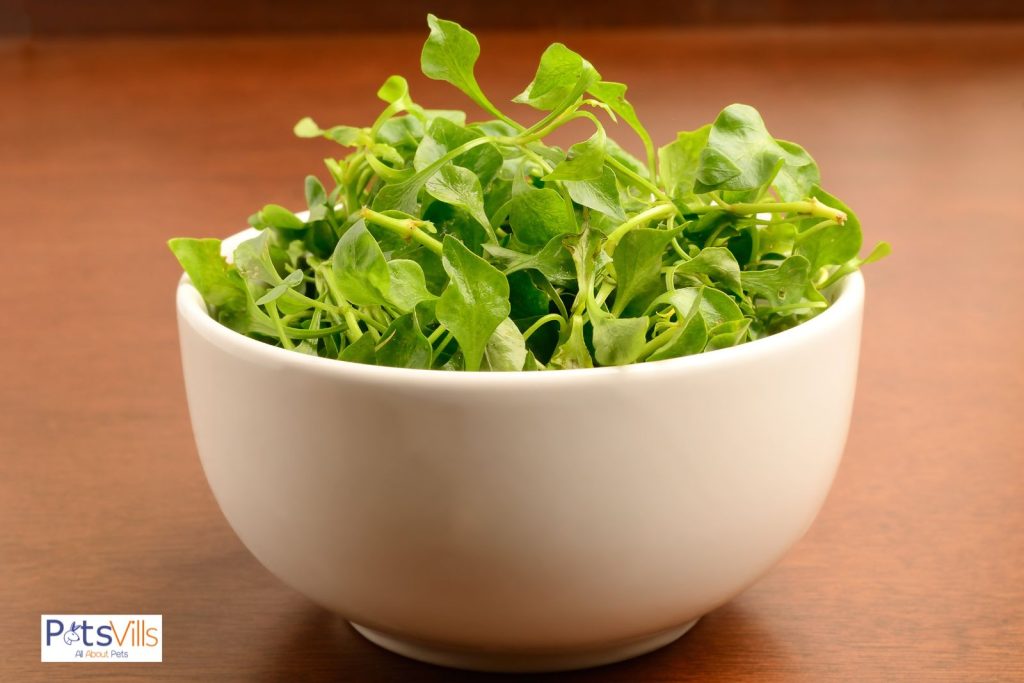
In my case, I prefer feeding it start to them. I start by washing the watercress to remove any dirt or debris.
It’s a crucial step because watercress often has bacteria due to it growing in water. So cleaning it off becomes a way of getting rid of any potential issues.
After cleaning it, use a dry paper towel and pat the vegetable gently until it’s dry. You want to remove as much moisture from the watercress before feeding.
If you don’t, it could cause them to ingest too much water. After all, this veggie has high water content, so this extra moisture increases it.
As for the second method, I’d suggest mixing it with leafy greens or fruits. It’s an ingenious way to give your guinea pig a boost in nutrition for the day.
Another choice would be mixing watercress in with your guinea pig’s hay. I’ve found this method to work even for the pickiest cavies.
How Many Watercress To Guinea Pigs?
As I mentioned earlier, you shouldn’t get carried away with watercress. It’s only safe for guinea pigs when fed in moderation with small amounts.
The issue stems from its high water content. Due to this, watercress in large quantities can cause digestive problems.
So I recommend only allowing it to make up at most 10% of your cavy’s diet. In other words, a small handful of watercress once per week should do the trick.
The rest of their diet should come from hay and leafy greens. If you need some suggestions for leafy greens, kale or lettuce are excellent choices.
Both veggies will be a solid secondary food to complement your cavy’s hay. Plus, their high nutritional value gives them an advantage over other options.
Other Vegetables That Guinea Pigs Can Eat
Watercress is only one of the numerous vegetables safe for pet guinea pigs. So let’s look at a few of my favorite options:
1. Asparagus
Asparagus earns a place on this list by providing a stable source of vitamin C. So it does an excellent job of preventing any issues like scurvy that could harm your cavy.
Guinea pigs eat asparagus, however, it’s not a daily vegetable for cavies. Asparagus isn’t suitable for this role as it contains some oxalate and phosphorous.
Both these components can be harmful to cavies in large doses. However, if the asparagus is fed to them occasionally, which means once weekly, there’s no harm.
2. Broccoli
Broccoli is another highly nutritious option packed with vitamin C. But I also have to point out that it’s no slouch with its amounts of vitamin A.
Sadly, vitamin A isn’t good and can cause harm. It’s another veggie where moderation is key when giving it to cavies.
Don’t forget to check whether can guinea pigs eat broccoli sprouts.
3. Spinach
Spinach is the most nutritious among these three vegetables. After all, humans consider it a superfood.
It’s not considering its high amounts of carotenoids, vitamin C, vitamin K, folic acid, iron, and calcium. So I always feel great about giving it to my furball.
More importantly, he seems to love. It often goes much like this adorable video of two guinea pigs eating spinach.
But like the previous two, it’s an occasional treat rather than a dietary staple. Spinach’s issues come from its high oxalate levels.
Also, you may check out other high fiber veggies for guinea pigs that are suitable for them.
FAQs
What leafy greens can guinea pigs eat daily?
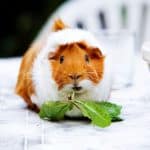
Several leafy greens are suitable for daily guinea pig feeding. Some include kale, parsley, lettuce, and cilantro.
Can guinea pigs eat watercress every day?
Watercress has way too much in it for everyday usage. Instead, owners should use watercress as a weekly treat to prevent digestive issues from overeating it.
Conclusion
So can guinea pigs eat watercress? Your cavy can munch on some watercress without issue under the right circumstances.
These circumstances are a small amount once per week. If owners stick to this guideline, it’s a solid nutritious addition to a guinea pig’s diet.
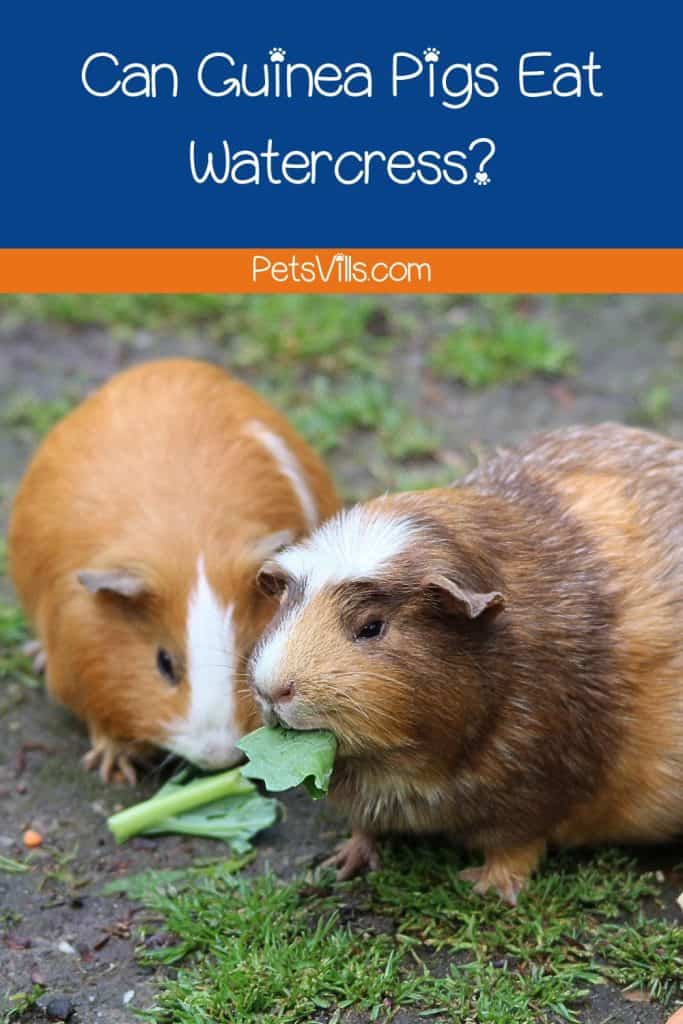
So, did you ever feed watercress to your guinea pigs? Let us know in the comments section!
Resources
- 1. a care guide for your Guinea Pig (Cavia porcellus) [Internet]. Available from: http://www.seattle.gov/documents/Departments/AnimalShelter/care-guides/care-sheet-guinea-pig.pdf
- 2. Link R. Can Watercress Fight Cancer? [Internet]. Dr. Axe. 2020. Available from: https://draxe.com/nutrition/watercress
- 3. Watercress, raw Nutrition Facts & Calories [Internet]. Self.com. 2018. Available from: https://nutritiondata.self.com/facts/vegetables-and-vegetable-products/2718/2
- 4. National Research Council (US) Subcommittee on Laboratory Animal Nutrition. Nutrient Requirements of the Guinea Pig [Internet]. Nih.gov. National Academies Press (US); 2017. Available from: https://www.ncbi.nlm.nih.gov/books/NBK231932/
- 5. Editorial P. Vitamin C Deficiency in Guinea Pigs [Internet]. www.petmd.com. 2010. Available from: https://www.petmd.com/exotic/conditions/cardiovascular/c_ex_gp_vitamin_c_deficiency

My name is Ben Roberts, and I absolutely love animals. So, naturally, I love writing about them too! As far as my animals, I have a Pit-bull, a Beagle-lab mix, a Chihuahua, and one old cat. Each one of them provides me with a new adventure every day. And the best part is they’re all best friends. Well, except the cat when he gets a little annoyed.
FIND HIM ON: FACEBOOK and TWITTER.
Read his latest ARTICLES
Learn more about Benhere

